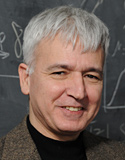 Aviv Bergman, Ph.D.
Aviv Bergman, Ph.D.
Harold and Muriel Block Chair in Systems & Computational Biology
Professor and Founding Chairman
Our research agenda involves multidisciplinary research into quantitative problems of evolutionary biology that can be approached using a combination of computational, mathematical and experimental tools. The focus of the research program is mainly on quantitative aspects of evolution and developmental biology, however, the relationship between these subjects and experimental molecular genetic studies of evolution and development are an integral part of the research efforts.
 Ruben Coen Cagli, Ph.D.
Ruben Coen Cagli, Ph.D.
Associate Professor
Our lab studies neural computation to advance understanding of how the brain produces perceptual experiences and guides behavior. We follow a highly interdisciplinary approach that combines theories of neural coding, advanced methods in machine learning and computer vision, psychophysics experiments, and in vivo electrophysiology through collaborations. Broad research topics in the lab include natural vision: Why computers can beat us at chess but don’t come close (yet) to our ability of understanding the world around us through our eyes? Behavioral variability: Why it is so hard to make 100 free throws in a row even if the basket doesn’t move? Uncertainty in perceptual decision-making: How do we decipher a road signal in heavy fog? We address these topics from the perspective of probabilistic inference, and develop models and experiments to probe how networks of neurons interact when evaluating the probability of different possible interpretations of the sensory input.
 Roger Larken Chang, Ph.D.
Roger Larken Chang, Ph.D.
Assistant Professor
My lab studies biological consequences of abiotic and chemical stresses spanning multiple scales of complexity from individual molecules to whole cells. Factors such as extreme temperature, ionizing radiation, desiccation, osmotic stress, and chemical exposures have complex impacts on biomolecules and cells, often challenging viability by affecting multiple loci and processes. We seek to elucidate mechanisms of toxicity, resistance, and response to microenvironmental stress and engineer translational protein interventions. We approach these problems through: 1) protein-structure-resolved, genome-scale metabolic network modeling and multi-omics measurements of microenvironmental stress phenotypes, 2) machine learning of modifications to protein structure caused by stress exposures, and 3) engineering proteins to alter how they are impacted by stress. Gaining understanding and control over biological stability under stress has far-reaching implications, such as prognostic markers and improved cancer treatment, developing drought resistant crops, preservation of biologicals, engineering industrial and therapeutic microbes, and broadly developing biotechnologies tailored to specific environmental conditions.
 David Cowburn, Ph.D.
David Cowburn, Ph.D.
Professor
David Cowburn's research centers on the application of structural biology, and particularly, nuclear magnetic resonance (NMR), to biological problems. He develops and applies useful new methods to challenging problems not readily addressed by standard methods. Current targets include the mechanism of rapid selective transport in the nuclear pore complex, and protein engineering using slicing methods. Some significant structural contributions include the first SH2 domain, the first proapoptotic BCL family member, high affinity complexes of specific SH3/ligands and stapled peptides/targets, and pleckstrin homology domain/PIP interactions. Methodological contributions cover new isotopic labeling methods, especially segmental labeling by expressed protein ligation, and production of kinases for NMR analysis; analysis of relaxation properties for weak self association, motion of multiple domains, contribution of CSA; in-cell NMR with advanced expression methods; mimics of protein-protein interactions, and molecular dynamics and NMR simulation methods. A significant area of focus is the structural biology of protein domains in signal transduction, including SH2, SH3, kinase, phosphatase, PH domains, and many others, and how natural ligands interact with them. Signaling disorders related to these domains lead to many disease states. Using NMR, there is a strong effort to understand how intrinsically disordered systems can be described, including those with 'fuzzy' interactions. In addition to NMR, the lab used molecular simulation by MD and Brownian motion methods, and small angle scattering methods.
 Eduardo Fajardo, Ph.D.
Eduardo Fajardo, Ph.D.
Research Associate Professor (PI: Andras Fiser)
 Andras Fiser, Ph.D.
Andras Fiser, Ph.D.
Professor
The era of genomics and high throughput experimentation has opened up an opportunity for science and caused a paradigm shift in research. The opportunity is to look at a biological system as a whole. Meanwhile the challenge in research has shifted from data acquisition to the problem of developing computational techniques for systemic and systematic analysis of biological information.
Research
topics in our lab include: the evolution of protein structures, modeling
protein structures (incorporating experimental restraints, modeling loops and
side chains, developing pairwise statistical energy functions, developing
sequence-to-structure alignment optimization algorithms) and designing new
protein structure topologies using fragments from existing structures. We are
also interested in the question of exploring life stage specific virulence
factors in apicomplexan pathogens by analyzing high throughput data from
proteomics (mass spectrometry and cross-linking), epigenomics (ChIPChip and
deep sequencing) and transcriptomics (mRNA expression) experiments and to
computationally simulate how the network of their transcriptional regulation
genes has to change to allow these pathogens to shuttle between the virulent
and non-virulent stages characterized by the high throughput experiments.
 Libusha Kelly, Ph.D.
Libusha Kelly, Ph.D.
Associate Professor
We study how ecosystem-level genetic variability influences adaptive responses to dynamic environments. Because microbial genomes of the same 'species' can be extremely diverse at the gene level, 16S characterization is not a reliable metric for the functional capacity of microbial populations. Metagenomics partially overcomes this issue by allowing the identification of functional genes in diverse community samples. Functional capacity, which can be selected for by environmental conditions, is accelerated by the ability of bacteria to exchange genes with each other and with viruses. A major question, therefore, is: How does variability at the gene level affect the functional capacity and interactions between members of microbial populations? Our interests are in 1) how environments select for different sets of microbial and viral genes, and 2) the influence of the commensal microbiota on human drug metabolism.
 Adam Kohn, Ph.D.
Adam Kohn, Ph.D.
Professor
My lab investigates how visual information is encoded and processed by populations of cortical neurons, and how this processing is affected by recent stimulus history, or adaptation. Our work thus addresses issues of neural coding, cortical plasticity, corticocortical signaling, and the neuronal basis of visual perception. Our approach involves multielectrode recordings in early and midlevel visual areas of anesthetized and awake, behaving macaque monkeys. We use computational methods to interpret and understand physiological data, and psychophysical methods to relate our findings to human perception. We have also begun using optogenetic tools, to further our understanding of corticocortical signaling in primate cortex.
 Yehonatan Sella, Ph.D.
Yehonatan Sella, Ph.D.
Educator
.1.jpg) Ian Willis, Ph.D.
Ian Willis, Ph.D.
Professor
Our laboratory is conducting basic research on the mechanisms of eukaryotic transcriptional regulation in response to nutrients and environmental and cellular stress. We are especially interested in defining the signaling pathways and the mechanisms that regulate transcription of ribosomal components and transfer RNAs since these processes are critically important for controlling cell growth. Deregulation of cell growth control is widely recognized as a key event in cell transformation and tumorigenesis and is relevant to a broad range of human diseases. In addition, as the synthesis of new protein synthetic machinery constitutes >85% of nuclear gene transcription in growing cell populations, the tight coordinate control of this process, which involves all three nuclear RNA polymerases, is considered to be critical for metabolic economy and ultimately for cell survival. Our research programs span genetics, molecular biology, biochemistry and structural biology and utilize budding yeast, mammalian cells and mice as model experimental systems.
 Sarah Wolfson, Ph.D.
Sarah Wolfson, Ph.D.
Staff Scientist
.jpg) Yinghao Wu, Ph.D.
Yinghao Wu, Ph.D.
Associate Professor
Cell adhesions are crucial for many biological phenomena such as tissue morphogenesis, immuneresponse and tumor invasion. The aggregations of membrane receptors on cellular interfaces during these physical processes initiate the elaborate intracellular networks of signaling pathways. Despite remarkable experimental achievements, there is still a long way to eventually form a mechanistic understanding of cell adhesion, and further decipher its intricate connection to signal transduction. By integrating computational analysis with experimental measurements, our lab focuses on developing multi-scale modeling frameworks to study the cross-talks between cell adhesion and cell signaling. We are particularly interested in asking the following questions: why and how different cells form contacts; when and where these contacts are formed at specific locations of our bodies; what are their functional impacts to the downstream signaling pathways, and further to our human health.
 Kenny Q Ye, Ph.D.
Kenny Q Ye, Ph.D.
Professor
Dr. Ye’s research focuses on statistical design and analysis of studies in genetics and genomics. He conducts methodological research in statistical modeling and data mining with high dimensional data. He is developing new statistical and computational approaches for novel application of next generation sequencing data in biomedical research. He is also developing novel statistical approaches for quantifying genetic contributions to disease traits.
Former Faculty
Parsa Mirhaji, M.D., Ph.D.
Research Associate Professor
Jessica Mar, Ph.D.
Assistant Professor
Andrew Yates, Ph.D.
Associate Professor
Odelia Schwartz, Ph.D.
Associate Professor
Eduardo Zaborowski, Ph.D.
Assistant Professor
Bojana Gligorijevic, Ph.D.
Instructor
Thomas MacCarthy, Ph.D.
Instructor
Eng Hui Yap, Ph.D.
Associate